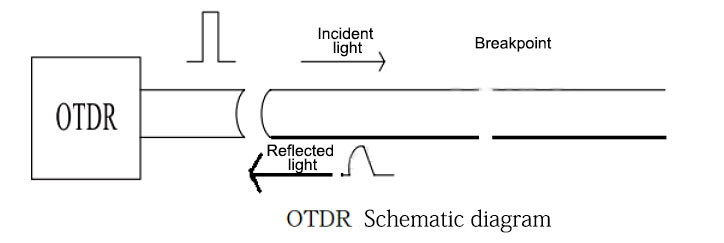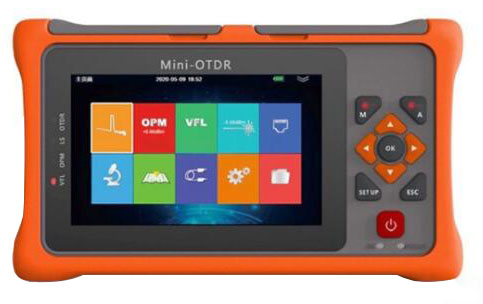Optical fiber communication, as a transmission network carrying a large amount of information, has certain risks and instabilities. In order to ensure the smooth operation and safety of optical fiber communication, it is necessary to develop a tool or instrument that can accurately measure the characteristics of optical fiber communication. To meet the requirement of fiber optic diagnosis in fiber optic communication, an optical time domain reflectometer with backward Rayleigh scattering as the measurement signal was generated.
The performance of fiber optic cable determines the quality of optical network transmission, and with the continuous development and construction of optical networks, the inspection and maintenance of fiber optic cable are becoming more and more important. Optical time domain reflectometer (OTDR) is an important tool for testing the integrity of fiber optic cables. It can be used to measure the length of fiber optic cables, measure transmission performance and connection attenuation, and detect the fault location of fiber optic cable links.
How an optical time domain reflectometer (OTDR) works?
OTDR is used to test fiber optic cables by injecting a high-power laser or light pulse from one end of the cable and receiving the reflected signal through the same side. When the light pulse is transmitted through the cable, part of the scattering and reflection will return to the transmitting end.

The optical time domain reflectometer (OTDR) will only measure the higher intensity of the reflected light signal, and by recording the time from transmission to return and the speed of signal transmission in the glass material, the length of the fiber optic cable can then be calculated using the formula.
In contrast to power and energy meters, which can directly measure the loss of fiber optic cable equipment, optical time domain reflectometers (OTDR) work indirectly. Optical Time Domain Reflectometer (OTDR) is made according to the principle of backward scattering and Fresnel inversion of light, using the backward scattered light generated when the light propagates in the optical fiber to obtain information about the attenuation, thus indirectly measuring the loss and fault location of optical fiber cables.
The OTDR test is carried out by launching light pulses into the optical fiber and then receiving the returned information at the OTDR port. When the light pulse is transmitted in the fiber, it will be scattered and reflected due to the nature of the fiber itself, connectors, splices, bending or other similar events. Part of the scattering and reflection will return to the OTDR. The useful information returned is measured by the detector of OTDR, and they are just time or curve segments at different positions in the optical fiber. From the time it takes for the signal to be emitted to return, and by determining the speed of light in the glass substance, the distance can be calculated. The following formula illustrates how OTDR measures distance.
d=(c×t)/2(IOR)
In this formula, c is the speed of light in a vacuum, and t is the total time from when the signal is transmitted to when it is received (two-way). Because the speed of light in glass is slower than in a vacuum, in order to measure distance accurately, the optical fiber under test must specify the refractive index IOR.
OTDR optical time domain reflection technology
OTDR technology can detect the link loss and health of optical fiber because it has the ability to test the loss at different locations along the entire fiber link, thus allowing the health of the fiber cable to be evaluated based on the loss at different locations measured by OTDR.
Based on the backward Rayleigh scattered light intensity generated by the pulsed light in the fiber, the measurement of attenuation along the fiber can be achieved at a single end of the fiber, based on the time difference between the moment of arrival of the scattered light and the moment of emission of the pulsed light, the attenuation points of the fiber can be spatially located. These two features, single-ended, breakage-free fiber attenuation measurement, and the "optical radar" effect have enabled OTDR technology to quickly replace conventional methods and demonstrate unique performance in the diagnosis and localization of fiber optic failure points in the field. The OTDR system can largely solve the problem of fiber optic communication operation health conditions.

Features of Optical Time Domain Reflectometer (OTDR)
- Intelligent trace analysis. Embedded intelligent trace analysis module can quickly and accurately analyze the event points and location information in the test curve and display it in the form of an event table.
- Ultra-short event blind zone. The FS OTDR has an ultra-short event blind zone of ≤0.8m, which is especially suitable for testing ultra-short fiber links or fiber patch cords.
- Convenient VFL function. Visual red light fault function can easily and quickly find the location of short-distance fiber optic link interruption points or lose points, so that maintenance personnel can take timely measures.
- Multiple jacks, flexible connection. Perfect jack types: RJ-45, USB, a power jack, etc., flexible connection, the USB port can be connected to the computer through the data, the line to directly export test data.
- Humanized touch interface. Transmissive color LCD display, the test results can be clearly observed under the sun, with a simple button design, simple and flexible operation.
Through the analysis of the measurement curve, the optical time domain reflectometer is an instrument for understanding the uniformity, defect, fracture, joint coupling, and other properties of the optical fiber. The optical time domain reflectometer uses the backscattered light generated when the light propagates in the optical fiber to obtain attenuation information, which can be used to measure the attenuation of the optical fiber, the loss of the joint, the location of the fault of the optical fiber, the loss distribution of the optical fiber along the length direction, etc. sisco.com offers fiber optic instruments and fiber optic OTDR testers of various sizes, which are indispensable tools when building, maintaining and monitoring fiber optic cables.

